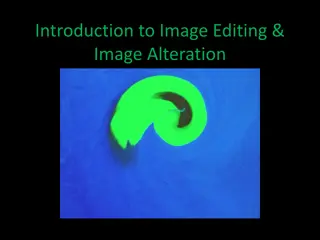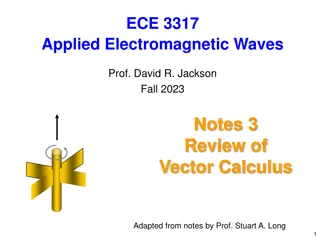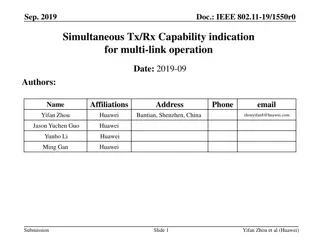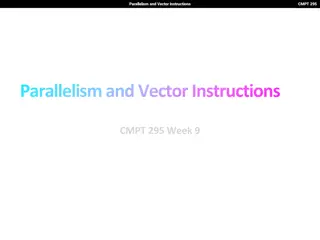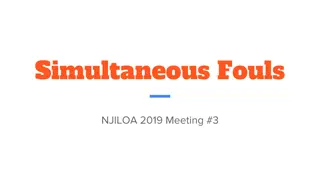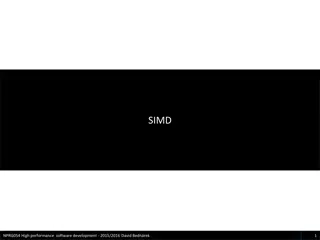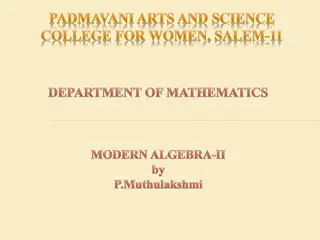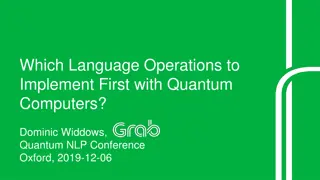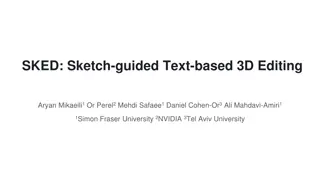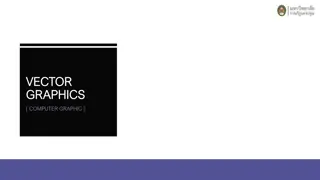Vector-Based Approach for Simultaneous Editing of Software Clones
This study explores the effectiveness of a vector-based approach in supporting simultaneous editing of software clones to overcome obstacles in software maintenance caused by identical or similar code fragments. It discusses different types of code clones, their definitions, and the importance of detecting and managing them efficiently. The research provides insights into techniques and tools for code clone detection and evaluation.
Download Presentation

Please find below an Image/Link to download the presentation.
The content on the website is provided AS IS for your information and personal use only. It may not be sold, licensed, or shared on other websites without obtaining consent from the author. Download presentation by click this link. If you encounter any issues during the download, it is possible that the publisher has removed the file from their server.
E N D
Presentation Transcript
On the Effectiveness of Vector-based Approach for Supporting Simultaneous Editing of Software Clones Seiya Numata1 Eunjong Choi 3 Norihiro Yoshida 2 Katsuro Inoue 1 1 Osaka University 3Nara Institute of Science and Technology 2Nagoya University Software Engineering Laboratory, Department of Computer Science, Graduate School of Information Science and Technology, Osaka University
Code Clone Code fragments that are identical or similar to each other Considered to be an obstacle to software maintenance. Clone pair Code clone 2 Department of Computer Science, Graduate School of Information Science and Technology, Osaka University
Types of Code Clone[1] Category Definition Type 1 Code fragments that are identical. Type 2 Code fragments that are structurally/syntactically identical. Type 3 Copied fragments that have undergone further modifications. Type 4 Code fragments that perform the similar computation, but are implemented through different syntactic variants. [1] C. K. Roy, J. R. Cordy, R. Koschke., Comparison and Evaluation of Code Clone Detection Techniques and Tools: A Qualitative Approach, Science of Computer Programming, 2009 3 Department of Computer Science, Graduate School of Information Science and Technology, Osaka University
Type 1 Code Clones Category Type 1 Type 2 Type 3 Type 4 Definition Code fragments that are identical. Code fragments that are structurally/syntactically identical. Copied fragments that have undergone further modifications. Code fragments that perform the similar computation, but are implemented through different syntactic variants. int int sum( sum(int int int sum = 0; sum = 0; for( for(int int i=0; i< sum = sum + data[ sum = sum + data[i i]; ]; } } return sum; return sum; } } Function A int[] data){ [] data){ int int sum( sum(int int int sum = 0; sum = 0; for( for(int int i=0; i< sum = sum + data[ sum = sum + data[i i]; ]; } } return sum; return sum; } } int[] data){ [] data){ i=0; i<data.length data.length; i++){ ; i++){ i=0; i<data.length data.length; i++){ ; i++){ Function B 4 Department of Computer Science, Graduate School of Information Science and Technology, Osaka University
Type 2 Code Clones Category Type 1 Type 2 Type 3 Type 4 Definition Code fragments that are identical. Code fragments that are structurally/syntactically identical. Copied fragments that have undergone further modifications. Code fragments that perform the similar computation, but are implemented through different syntactic variants. int int sum( sum(int int int sum = 0; sum = 0; for( for(int int i i=0; sum = sum + data[ sum = sum + data[i i]; ]; } } return sum; return sum; } } Function A int[] data){ [] data){ int int sum( sum(int int int sum = 0; sum = 0; for( for(int int j j=0 sum = sum + sum = sum + data[ } } return sum; return sum; } } int[] data){ [] data){ =0; i i< <data.length data.length; ; i i++){ ++){ =0; ; j j< <data.length data.length; ; j j++ data[j j]; ]; ++){ ){ Function B 5 Department of Computer Science, Graduate School of Information Science and Technology, Osaka University
Type 3 Code Clones Category Type 1 Type 2 Type 3 Type 4 Definition Code fragments that are identical. Code fragments that are structurally/syntactically identical. Copied fragments that have undergone further modifications. Code fragments that perform the similar computation, but are implemented through different syntactic variants. int int sum( sum(int int int sum = 0; sum = 0; for( for(int int i=0; i< sum = sum + data[ sum = sum + data[i i]; ]; } } return sum; return sum; } } Function A int[] data){ [] data){ int int sum( sum(int int int sum = 0; sum = 0; for( for(int int i=0; i< sum sum += } } return sum; return sum; } } int[] data){ [] data){ i=0; i<data.length data.length; i++){ ; i++){ i=0; i<data.length data.length; i++){ += data[ data[i i]; ]; ; i++){ Function B 6 Department of Computer Science, Graduate School of Information Science and Technology, Osaka University
Type 4 Code Clones Category Type 1 Type 2 Type 3 Type 4 Definition Code fragments that are identical. Code fragments that are structurally/syntactically identical. Copied fragments that have undergone further modifications. Code fragments that perform a similar computation, but are implemented through different syntactic variants. int int sum( sum(int int int sum = 0; sum = 0; for( for(int int i=0; i< sum = sum + data[ sum = sum + data[i i]; ]; } } return sum; return sum; } } Function A int[] data){ [] data){ int int sum( sum(int int int sum = 0; sum = 0; while( while(i i< <data.length sum sum += data[ += data[i i]; ]; i i++; ++; } } return sum; return sum; } } int[] data){ [] data){ i=0; i<data.length data.length; i++){ ; i++){ data.length){ ){ Function B 7 Department of Computer Science, Graduate School of Information Science and Technology, Osaka University
CCFinder: A token-based Approach [2] A token-based code clone detection tool Detect Type1 and Type2 code clones at high speed. Widely used in the many companies as well as universities [3], [4] [2] T. Kamiya, S. Kusumoto, and K. Inoue. CCFinder: a multilinguistic token-based code clone detection system for large scale source code. IEEE Trans. Softw. Eng., Vol. 28, No. 7, pp. 654 670, 2002. [3] L. Barbour, F. Khomh, Y. Zou, An empirical study of faults in late propagation clone genealogies, J. Softw. Evol. and Proc. vol. 25, no. 11, pp. 1139 - 1165 [4] Y. Yamanaka, E. Choi, N. Yoshida, K. Inoue, and Tateki Sano. 2012. Industrial application of clone change management system. In Proc. of IWSC '12.pp. 67-71 2012. 8 Department of Computer Science, Graduate School of Information Science and Technology, Osaka University
Vector-based Approach [5] STEP1 Extract word from each functions in the source code. STEP2: Generate a feature vector from each function, based on the weighted word. STEP3: Cluster the feature vectors using the Locality-Sensitive-Hashing algorithm. STEP4: Detect function clones based on the similarities between each pair of feature vectors. STEP1 Function A word count xxx 3 yyy 2 Function B word count Source code (Input) xxx 3 zzz 4 List of words 9 [5] Yamanaka et al.:: A high speed function clone detection based on information retrieval technique. IPSJ Journal .2014 Department of Computer Science, Graduate School of Information Science and Technology, Osaka University
Vector-based Approach [5] STEP1 Extract word from each functions in the source code. STEP2: Generate a feature vector from each function, based on the weighted word. STEP3: Cluster the feature vectors using the Locality-Sensitive-Hashing algorithm. STEP4: Detect function clones based on the similarities between each pair of feature vectors. STEP1 STEP2 Function A word count Function A , , 2 1 a a xxx 3 { , } a yyy 2 3 Function B word count Function B Source code (Input) xxx 3 { , , , } b b b zzz 4 1 2 3 List of words Feature vectors [5] Y.. Yamanaka, E. Choi, N. Yoshida, K. Inoue:: A high speed function clone detection based on information retrieval technique. IPSJ Journal 55(10), 2245 2255 (2014), in Japanese 10 Department of Computer Science, Graduate School of Information Science and Technology, Osaka University
Vector-based Approach [5] STEP1 Extract word from each functions in the source code. STEP2: Generate a feature vector from each function, based on the weighted word. STEP3: Cluster the feature vectors using the Locality-Sensitive-Hashing algorithm. STEP4: Detect function clones based on the similarities between each pair of feature vectors. STEP1 STEP2 STEP3 Function A word count Function A , , 2 1 a a xxx 3 Function A Function B { , } a yyy 2 3 Function B Function C Function D Function E Clusters of functions word count Function B Source code (Input) xxx 3 { , , , } b b b zzz 4 1 2 3 List of words Feature vectors [5] Y.. Yamanaka, E. Choi, N. Yoshida, K. Inoue:: A high speed function clone detection based on information retrieval technique. IPSJ Journal 55(10), 2245 2255 (2014), in Japanese 11 Department of Computer Science, Graduate School of Information Science and Technology, Osaka University
Vector-based Approach [5] STEP1 Extract word from each functions in the source code. STEP2: Generate a feature vector from each function, based on the weighted word. STEP3: Cluster the feature vectors using the Locality-Sensitive-Hashing algorithm. STEP4: Detect function clones based on the similarities between each pair of feature vectors. STEP1 STEP2 STEP3 STEP4 Function A similarity Function pair clone word count Function A , , 2 1 a a xxx 3 0.95 Function A Function B Function A Function B { , } a yyy 2 3 0.70 Function C Function D Function B Function C Function D Function E Clusters of functions 0.70 Function C Function E word count Function B Source code (Input) xxx 3 0.90 Function D Function E { , , , } b b b zzz 4 1 2 3 List of words Feature vectors Clone detection [5] Y.. Yamanaka, E. Choi, N. Yoshida, K. Inoue:: A high speed function clone detection based on information retrieval technique. IPSJ Journal 55(10), 2245 2255 (2014), in Japanese 12 Department of Computer Science, Graduate School of Information Science and Technology, Osaka University
Evaluation Result from Previous Study[5] measured the precision and recall based on the corpus proposed by Tempero et.al [6]. Precision=|???????????? ????????| |???????????? | Recall =|???????????? ????????| |????????| Project Name Apache Ant Argo UML # Clone Pairs 474 880 Precision 92% 96% Recall 62% 53% [5] Y. Yamanaka, E. Choi, N. Yoshida, K. Inoue:: A high speed function clone detection based on information retrieval technique. IPSJ Journal 55(10), 2245 2255 (2014), in Japanese [6] E. Tempero, C. Anslow, J. Dietrich, T, Han, J. Li, M. Lumpe, Hayden Melton, and James Noble. The qualitas corpus: a curated collection of java code for empirical studies. In Proc. of APSEC, pp. 336 345, 2010. 13 Department of Computer Science, Graduate School of Information Science and Technology, Osaka University
Motivation of this Study Developers frequently perform a query-based search for similar code fragment. query Developer finds defect Similar code fragments extract Code clone detection tool Subject Source file Inspect the existence of a defect 14 Department of Computer Science, Graduate School of Information Science and Technology, Osaka University
Motivation of this Study We investigate the effectiveness of the vector-based approach. in terms of query-based use for fixing of buggy clones A collaborative IT company asked us to investigate it. query Similar code fragments extract Vector-based approach Source files 15 Department of Computer Science, Graduate School of Information Science and Technology, Osaka University
Dataset for Evaluation [7] Each case has (a) a buggy code fragment. (b) buggy code clones of (a) including same defects. (c) commit ID of Git. Dataset has 58 cases from PostgreSQL, Git and Linux Kernel. Clone pair case (b) Clone pair (a) (b) 16 [7] J. Li and Michael D Ernst. CBCD: Cloned buggy code detector. In Proc. of ICSE , pp. 310 320, 2012. Department of Computer Science, Graduate School of Information Science and Technology, Osaka University
Investigation Method Data set Git repository STEP1 Snapshot 17 Department of Computer Science, Graduate School of Information Science and Technology, Osaka University
Investigation Method Clone detection tool Data set Buggy code fragments (query) Git repository STEP1 STEP2 Snapshot Set the threshold of vector-based approach as 0.9 and 0.5 respectively. Set 10 tokens as minimum length of a token sequence for CCFinder. 18 Department of Computer Science, Graduate School of Information Science and Technology, Osaka University
Effectiveness Criterion Recall Precision F-measure 19 Department of Computer Science, Graduate School of Information Science and Technology, Osaka University
Recall Percentage of code clones that could be detected by the tool from the set of code clone containing the defect cases R????? =??? ??? ??? # of code clone as a defect case: CCe # of code clone detected by the tool: CCd 20 Department of Computer Science, Graduate School of Information Science and Technology, Osaka University
Precision Percentage of code clones containing the defect cases detected by the tool P???????? =??? ??? ??? # of code clone as a defect case: CCe # of code clone detected by the tool: CCd 21 Department of Computer Science, Graduate School of Information Science and Technology, Osaka University
F-measure Harmonic average of precision and recall F ??????? =2 ?????? ????????? ?????? +????????? 22 Department of Computer Science, Graduate School of Information Science and Technology, Osaka University
Result of Investigation Vector-based approach Threshold=0.9 41 CCFinder Threshold=0.5 293 Number of detections Correct number of detections Recall Precision F-measure 2274 24 31 31 0.41 0.59 0.48 0.53 0.11 0.18 0.53 0.01 0.02 23 Department of Computer Science, Graduate School of Information Science and Technology, Osaka University
Discussion In terms of precision and F-measure The vector-based approach with threshold=0.9 is the highest score. most suitable approach when developers have only a limited amount of time In terms of recall The vector-based approach with threshold=0.5 and CCFinder are the highest score. However, the precision of CCFinder is extremely low. more suitable for the development of a highly-reliable software system 24 Department of Computer Science, Graduate School of Information Science and Technology, Osaka University
Summary and Future Work Summary We investigate the effectiveness of the vector-based approach. in terms of query based use for fixing of buggy clones The result shows high precision and F-measure with threshold=0.9. Future work Apply the vector-based approach into the process of an industrial software development. 25 Department of Computer Science, Graduate School of Information Science and Technology, Osaka University






